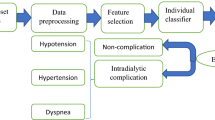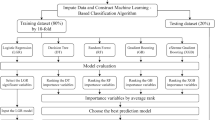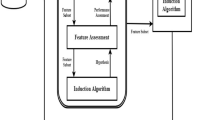Abstract
We propose an improved model based on LVW embedded model feature extractor and ensemble learning for improving prediction accuracy of hemodialysis timing in this paper. Due to this drawback caused by feature extraction models, we adopt an enhanced LVW embedded model to search the feature subset by stochastic strategy, which can find the best feature combination that are most beneficial to learner performance. In the model application, we present an improved integrated learners for model fusion to reduce errors caused by overfitting problem of the single classifier. We run several state-of-the-art Q&A methods as contrastive experiments. The experimental results show that the ensemble learning model based on LVW has better generalization ability (97.04%) and lower standard error (± 0.04). We adopt the model to make high-precision predictions of hemodialysis timing, and the experimental results have shown that our framework significantly outperforms several strong baselines. Our model provides strong clinical decision support for physician diagnosis and has important clinical implications.





Similar content being viewed by others
References
Kanno, Y., Kanda, E., Comparison of accuracy between pre-hemodialysis and post-hemodialysis levels of nutritional factors for prediction of mortality in hemodialysis patients[J]. Clinical Nutrition, 2017. https://doi.org/10.1016/j.clnu.2017.12.012.
Bakkaloğlu, SA., Kandur, Y., Serdaroğlu, E. et al., Effect of the timing of dialysis initiation on left ventricular hypertrophy and inflammation in pediatric patients.[J]. Pediatric Nephrology, 32(9):1–8, 2017.
Daugirdas, J. T., Hemodialysis treatment time: As important as it seems? Semin. Dial. 30:93–98, 2017.
Rivara, M. B., and Mehrotra, R., Timing of dialysis initiation: What has changed since IDEAL? Semin. Nephrol. 37:181–193, 2017.
Low, S., Lim, S. C., Zhang, X., Zhou, S., Yeoh, L. Y., Liu, Y. L., Tavintharan, S., and Sum, C. F., Development and validation of a predictive model for chronic kidney disease progression in type 2 diabetes mellitus based on a 13-year study in Singapore. Diabetes Res. Clin. Pract. 123:49–54, 2017.
Neves, J., Martins, M. R., Vilhena, J., Neves, J., Gomes, S., Abelha, A., Machado, J., and Vicente, H. A., Soft computing approach to kidney diseases evaluation. J. Med. Syst. 39:131, 2015.
Polat, H., Danaei Mehr, H., and Cetin, A., Diagnosis of chronic kidney disease based on support vector machine by feature selection methods. J. Med. Syst. 41:55, 2017.
Sedighi., Z, Ebrahimpour-Komleh., H, Mousavirad., S. J., Featue selection effects on kidney desease analysis[C]//Technology, Communication and Knowledge (ICTCK), 2015 International Congress on. IEEE, 2015:455–459, 2015.
Lotfnezhad Afshar, H., Ahmadi, M., Roudbari, M., and Sadoughi, F., Prediction of breast cancer survival through knowledge discovery in databases. Global J. Health Sci. 7:392–398, 2015.
Caceres, C. A., Roos, M. J., Rupp, K. M. et al., Feature Selection Methods for Zero-Shot Learning of Neural Activity[J]. Frontiers in Neuroinformatics, 11:41, 2017.
Wang, L., Wang, Y., and Chang, Q., Feature selection methods for big data bioinformatics: A survey from the search perspective. Methods (San Diego, Calif) 111:21–31, 2016.
Yang., Y, Chen., Y, Wang., Y. et al., Modelling a combined method based on ANFIS and neural network improved by DE algorithm: A case study for short-term electricity demand forecasting[J]. Applied Soft Computing, 49:663–675, 2016.
Chowdhury, A. K., Tjondronegoro, D., Chandran, V., and Trost, S. G., Ensemble methods for classification of physical activities from wrist accelerometry. Med. Sci. Sports Exerc. 49:1965–1973, 2017.
Ladds, M. A., Thompson, A. P., Slip, D. J., Hocking, D. P., and Harcourt, R. G., Seeing it all: Evaluating supervised machine learning methods for the classification of diverse otariid behaviours. PLoS One 11:e0166898, 2016.
Vajda, S., Karargyris, A., Jaeger, S. et al., Feature selection for automatic tuberculosis screening in frontal chest radiographs. J. Med. Syst. 42(8):146, 2018.
Ulusoy, S., Ozkan, G., Guvercin, B., and Yavuz, A., The relation between variability of intact parathyroid hormone, calcium, and cardiac mortality in hemodialysis patients. Artif. Organs 40:1078–1085, 2016.
Maduell, F., Varas, J., Ramos, R., Martin-Malo, A., Perez-Garcia, R., Berdud, I., Moreso, F., Canaud, B., Stuard, S., Gauly, A., Aljama, P., and Merello, J. I., Hemodiafiltration reduces all-cause and cardiovascular mortality in incident hemodialysis patients: A propensity-matched cohort study. Am. J. Nephrol. 46:288–297, 2017.
Li, H., Zhu, L., Meng, S. et al., Blockchain-based data preservation system for medical data. J. Med. Syst. 42(8):141, 2018a.
Srividya, M., Mohanavalli, S., and Bhalaji, N., Behavioral modeling for mental health using machine learning algorithms. J. Med. Syst. 42(5):88, 2018.
Khanum, N., Mysore-Shivalingu, M., Basappa, S., Patil, A., and Kanwar, S., Evaluation of changes in salivary composition in renal failure patients before and after hemodialysis. J Clin Exp Dent 9:e1340–e1345, 2017.
Kirar, J. S., and Agrawal, R. K., Relevant feature selection from a combination of spectral-temporal and spatial features for classification of motor imagery EEG. J. Med. Syst. 42(5):78, 2018.
Sebaa, A., Chikh, F., Nouicer, A. et al., Medical big data warehouse: Architecture and system design, a case study: Improving healthcare resources distribution. J. Med. Syst. 42(4):59, 2018.
Li, B., Li, J., Lan, X. et al., Experiences of building a medical data acquisition system based on two-level modeling. Int. J. Med. Inform. 112:114–122, 2018b.
Altman, R., Artificial intelligence (AI) systems for interpreting complex medical datasets. Clinical. Pharmacol. Ther. 101(5):585, 2017.
Xiang-Yi K , Ren-Zhi W , Neurosurgery D O . Artificial Intelligence and Its Application in Medical Field[J]. Journal of Medical Informatics, 2016.
Vanneschi, L., Horn, D. M., Castelli, M. et al., An artificial intelligence system for predicting customer default in E-commerce. Expert Syst. Appl. 104:1–21, 2018.
Funding
This study was funded by the Science and Technology Plan Project of Sichuan Province under Grant 2016GZ0092.
Author information
Authors and Affiliations
Corresponding author
Ethics declarations
Conflict of interest
The authors declare no conflict of interest. The funders had no role in the design of the study; in the collection, analyses, or interpretation of data; in the writing of the manuscript, and in the decision to publish the results.
Ethical approval
This article does not contain any studies with human participants performed by any of the authors.
Additional information
This article is part of the Topical Collection on Systems-Level Quality Improvement
Rights and permissions
About this article
Cite this article
Xiong, Cz., Su, M., Jiang, Z. et al. Prediction of Hemodialysis Timing Based on LVW Feature Selection and Ensemble Learning. J Med Syst 43, 18 (2019). https://doi.org/10.1007/s10916-018-1136-x
Received:
Accepted:
Published:
DOI: https://doi.org/10.1007/s10916-018-1136-x




